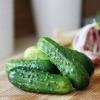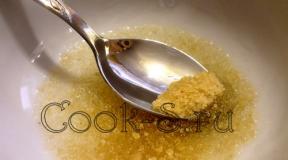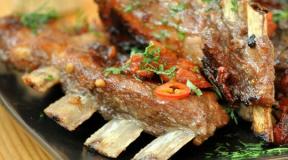The best beef steak recipe. Beef steak in a frying pan
I've been cooking steaks for many years, from a wide variety of meats, and I daresay I do it well. In this article, I decided to collect all my experience, which will allow you to achieve perfection in cooking steaks. And feel free to follow the links—they'll take you to other articles that cover various aspects of grilling and serving steak, like cooking the meat or making steak sauces.
|
|
How to cook a perfect steak
Cooking a perfect steak can be a challenge even for a skilled chef: small pieces of meat can cook too quickly, becoming dry and tough, too large pieces can burn on the outside without being cooked through on the inside. If you're new to cooking steak, I recommend using a heavy skillet or grill pan—a charcoal or electric grill is also great for steaks, but a skillet will be easier to control the temperature.
Step 1 - Prepare the Steak
Cooking a steak starts with choosing meat from a store or butcher shop. As a rule, imported beef is used for steaks, and although high-quality steaks from Russian beef have recently begun to appear, foreign terminology is still used to classify cuts of meat. The easiest way to practice frying steaks is on steaks. ribeye And striploin, also known as New York (in our classification, these cuts more or less correspond to thick and thin edges) - they are soft in themselves, and will turn out tasty, even if you miss the mark a little.
Pay attention to the so-called marbling of meat: fat should be distributed as evenly as possible throughout the meat, then during cooking of the steak these inclusions of fat will melt, making the meat more tasty and juicy. Classic steak thickness - 2.5 centimeters, and if you buy meat already sliced, make sure that the steaks are of the correct thickness, but if you take a large piece, try on how you will cut it. So let's get started.
- If the steak was frozen, defrost it overnight in the refrigerator and pat dry.
- Remove the steak from the refrigerator at least 20 minutes before grilling to allow it time to come to room temperature.
- Brush both sides of the steaks with vegetable oil (I use olive oil, but you can use any unflavoured vegetable oil instead) and season generously with salt.
| See also: | |
Step 2 - Heat the pan
- Heat the skillet over medium-high heat until it is hot but not smoking (if the skillet is too hot, the steak will burn on the outside before the inside is cooked, resulting in a tough steak).
- The sizzling sound you hear after you place the steaks in the pan will let you know if it has reached the desired temperature.
- Another way to check the heating of a frying pan is to drop a little water on it: if you have heated the frying pan well, the droplet will form an elastic ball that will run across the surface of the frying pan like crazy.
Step 3 - Cook to taste
- For medium rare, place the steaks in the pan without touching and let them cook for 1 minute.
- Carefully turn the steaks over with tongs (be careful not to damage them to prevent any juices from escaping) and cook for 1 minute more to form a crust.
- Turn the steaks over again and reduce the heat to medium. Fry for 2 minutes, turn over, and cook for another 2 minutes.
- To test for doneness, gently press the steak with your fingertip. The rare steak should be soft and pliable, well-done and firm, and the medium steak, as it should be, will be something in between.
Steak cooking time
You can vary the steaks to your taste by increasing or decreasing the cooking time. The following is an approximate time for a 2.5cm thick steak. Thicker steaks require longer cooking times and vice versa.
- Rare (with blood) - 1-2 minutes on each side, let rest for 6-8 minutes;
- Medium rare (low-done) - 2-2.5 minutes on each side, let rest for 5 minutes;
- Medium (medium roast) - 3 minutes on each side, let rest for 4 minutes;
- Well done (well done) - 4.5 minutes on each side, let rest for 1 minute.
However, the most accurate (though not always accessible to a beginner) way to determine the degree of doneness of a steak is to use a meat thermometer.
| See also: | |
Step 4 - Let the steaks rest
- Leaving the meat to sit for a while is just as important as cooking it correctly - during these few minutes the juices will be distributed inside the piece, the temperature outside and inside will equalize, and the entire steak will become warm, juicy and tender.
- Remove the steaks from the pan, season with black pepper and place in a baking dish. Place a piece of butter on each steak, cover with foil and leave in a warm place for 4-5 minutes.
- Remember, it is better to let the steak rest longer than necessary, not less, this will allow it to acquire the greatest flavor and tenderness.
| See also: |
Many people dream of cooking a good steak, but not everyone succeeds. Meanwhile, the cooking process is very simple. You just need to know some nuances and secrets.
If you take regular beef, then the only option that will work for steak is tenderloin.
If you take marbled beef, then there are more options. In general, producers of marbled beef supply stores with already cut and sliced steaks in vacuum packaging. In addition to premium cuts like Ribeye, which is a thick end, and Striploin, which is in turn a thin end, as well as Filet Mignon, the carcass of the marbled steer is rich in a variety of cuts of excellent meat, suitable specifically for frying in a pan and on the grill. The main differences between premium marbled meat and alternative parts of the carcass can be considered the ease of processing and cutting the steak, and the softness of the resulting steak.
The steak should be thick, the thicker it is, the easier it is to cook. If the steak turns out to be thin, then you need to be a professional to catch the marbling, prevent the fat from leaving the meat, and not overcook it. So approximately 2 - 2.5 cm in thickness is a normal steak. For thinner steaks, reduce the heat treatment time.
Is it necessary to beat back?
Steaks are not tenderized. Even if they are made from ordinary beef, from tenderloin. Its upper, thickest part is used for steaks and does not need to be beaten. The tenderloin is cut closer to the tail, but here they are no longer making steaks, but splints, for example.
Blue - so-called raw roasting (no more than 2-3 minutes), the meat inside has a temperature of no higher than 39-40°C.
Rare is practically rare meat (only 3-4 minutes to cook). However, there are many connoisseurs of just such steaks, fried on the outside and red on the inside. meat temperature is 45-48 °C
Medium rare is lightly fried meat with juice that has a rich pink color. (Cooking will take 5-6 minutes), the temperature of the meat will be about 48-53 °C
Medium – medium-rare meat, the most preferred degree of roasting, at which the meat retains light pink juice inside. (Cooking will take 6-7 minutes), meat temperature will be 53-57 °C
Medium Well is normally fried meat with clear juice inside (frying will take 8-9 minutes), meat temperature is about 57-62 °C
Well Done is well-done meat that is grayish to brown in color, without red or pink streaks, and with virtually no clear juices. Cooking will take about 10 minutes or even more, the temperature of the meat will be 65°C and above.
What to fry with
A cast iron skillet works best. Regular or grooved grill pan. It removes excess fat, and the meat is fried well, forming a crust on it.
How to fry the right steak?
- The thickness of a traditional steak, at which you can accurately determine the cooking time and get an excellent result, is at least 2.5 cm.
When removing the meat from the refrigerator, wash it, dry it with a towel, and leave it on the plate for at least 20-25 minutes. The meat should be at room temperature. The fact is that cold meat behaves differently when heated and you risk ruining the taste of the dish.
The pan needs to be as hot as possible before frying.
You can apply your favorite vegetable oil to the steak itself, or you can coat the frying pan (I always grease the steak with olive oil, I don’t grease the frying pan). When putting meat on the grill, you do not need to grease it with oil. Do not add salt or pepper!
Fry the steak on each side to the desired degree, on average 3 minutes (for a 2.5 cm steak), then reduce the heat a little and fry the meat a little more on each side.
For medium doneness, 2 cm thick, I fry steaks for 1.5 - 2 minutes on one side, then on the other, then another 1.5 minutes on each side, without turning down the heat.
Fry steaks 1-1.5 cm thick for 1.5-2 minutes on each side, do not fry again.
Place the steak on a preheated plate and leave to rest for a short time. The warmth of the plate and a few minutes of rest will allow the meat not to cool down and will most fully reveal its luxurious taste and juiciness.
Season with salt and pepper. You can put a piece of butter.
There is another cooking method:
Heat a dry frying pan and place the meat on it. No oil is required; our piece of meat is greased with olive oil. The meat must be fried until golden brown. 30 seconds on each side, no more. And then bring it to readiness in the oven.
Your steak is ready! Bon appetit!
One of my favorite dishes that I like to cook for myself is grilled steak. Cooking the right steak is not such a simple process. But I improved my recipe over and over again. This step-by-step instruction will explain to you in detail how to cook beef steak at home in a frying pan.
This guide is intended for people with cooking experience. For those who do not feel comfortable in the kitchen, it is better not to take on this dish. Cooking the perfect steak is a very precise and time-sensitive process. But you can easily cope with this if you prepare everything correctly and follow my instructions.
Stage 1: Equipment and ingredients
Here's a list of what you'll need to cook steak.
Devices
- plate
- one pan, the size of your steak
- forceps
- plate
- clock with timer
Ingredients
- One steak
- Olive oil
- Butter
- Salt
- Pepper
- Fresh garlic (or dried)
Step 2: Buying a Steak

The first thing we need to do is find the right steak to cook. To do this, it is better to go to a place with a large selection of quality meat. In these places the meat is usually a little more expensive, but in my opinion it's worth it.
I took a 250 gram selected steak. It is small enough for one person and relatively inexpensive. Choose meat that looks appetizing to you! If funds allow, you can choose an even better steak, but this miniature piece will do just fine for the lesson.
When you're at the store, make sure you have the remaining ingredients, such as olive oil, butter, salt, pepper and garlic. It's a great option to buy a few fresh heads of garlic if you don't want to use garlic powder.
Step 3: Preparing the Meat

When you get home you should let the meat warm through. In the store it was in the refrigerator, it was very cold there. Cooking a cold steak is not a good idea.
First, unwrap the meat and let it rest on a plate. While it sits, use salt and pepper to season the steak. Sprinkle on all sides, do not skimp on seasonings.
Usually it takes 20 minutes for the meat to warm up, it all depends on the size of the piece and how long it was frozen. It is important to warm the meat thoroughly so that during cooking in the pan you do not end up with a cold center.
While the steak is heating, take your time and make sure all other utensils and ingredients are ready. Place the frying pan over high heat. Before it gets hot, add enough olive oil to cover the bottom of the pan. You will need a lot more oil in the later stages of the process.
Step 4: Searing the steak

The next step is very important and can be dangerous. At this point, the pan should be very hot. You will use tongs to place the steak into the hot oil. At these high temperatures there will be a lot of splatter so be careful when turning the steak.
After you place the steak in the pan, start counting the time; it should lie there for 1 minute. After one minute has passed, turn it over to the other side and leave it like that for another 1 minute.
After a minute has passed, turn the steak sideways to sear the edges. Keep it this way until the edge is colored the same as the rest of the meat. Do this on both sides. Tilt the pan so that the oil pools on one side of the pan, this will make it easier to sear the edges of the steak. As in the photo above.
You should keep turning the steak at 1 minute intervals until you feel it is well cooked. The total length of time for this step depends on your preference and the thickness of your steak.
Now you are ready for the next step.
Step 5: Cooking the Steak

At this stage, the steak is already fried on all sides and the meat juice is sealed inside. Keep the stove low, medium heat.
It's time to cook the meat to the doneness you like. There are no exact instructions for cooking time, it depends on the thickness of the steak, the heat of the stove and other factors. You just have to check the meat often enough to make sure it's done or if you need to keep it on the stove. For this tutorial, I cooked my steak medium rare, leaving a small pink part in the middle.
Now that the pan is no longer so hot, you still continue to turn the steak at intervals of 1 minute.
Now is the time to add the garlic and oil. Cut a good piece of butter and place it in a frying pan, seasoning it all generously with garlic. I used garlic powder since I didn't have any fresh on hand. As you continue to turn the steak, allow the meat to absorb all that good flavor. Keep in mind that I am describing how to make a perfect steak, not a healthy one.
I cooked this steak for just 8 minutes, turning every minute to achieve medium rare. Again, I remind you that everything depends on the thickness of the piece and the cooking temperature, so I can’t guarantee you exactly the same result in 8 minutes.
Use tongs to check the meat. When you feel that the piece of meat has begun to thicken, it is probably medium done.
Once you've cooked the steak in the pan for a reasonable amount of time, it's time to remove it and place it on a clean plate.
Step 6: Take your time
Have you finished cooking your steak and are you ready to eat it? PATIENCE!
You need to let the meat rest before cutting it.
To ensure a truly juicy steak, the meat must be allowed to “rest” after cooking. If you cook a steak medium rare and cut it right away, the juices will run all over the cutting board. As a result, the meat will turn out less juicy, less aromatic and with an insufficiently rich taste.
Let the meat rest for 5 minutes. If you're not that patient, enjoy a bottle of beer in the meantime (age permitting!).
Step 7: Eat and Enjoy

You have been patient enough. You have waited 5 minutes. Now you can enjoy the amazing taste of steak cooked at home with your own hands.
This steak doesn't require any sauces. The sauce will only destroy the natural flavor you created on your stovetop.
Stewed vegetables and cold beer will perfectly complement your meat masterpiece. Enjoy!
Steak is a piece of meat that is fried in a frying pan or grill until golden brown. But pulp taken from any part of a beef carcass is not suitable for it. It is prepared only from premium beef.
For it, fillet with a minimum amount of connective tissue is chosen. Has such qualities only tenderloin. It is located inside the carcass and does not participate in muscle movement. It is a large piece of teardrop-shaped fillet.
The flesh of the brisket is very soft, without veins, so it cooks quickly.
In a pinch, thin and thick edges can be used for steak. But this meat does not always meet culinary requirements.
Only meat from young bulls, whose age does not exceed one and a half years, is suitable for steak.
You should also not use fresh meat. It should rest in the freezer for at least twenty days. During this time, a fermentation process occurs in it, due to which the pulp fibers soften. Steak from such meat turns out soft and juicy.
Beef steak in a frying pan: subtleties of cooking
- Steak meat is cut into large pieces across the grain. During heat treatment, the heat passes inside the fillet faster, and it warms up evenly.
- Frozen pulp is thawed in the refrigerator over several hours. You cannot defrost meat in the microwave, as the temperature is disrupted and the steak cooks unevenly.
- Steaks are cut into equal pieces no less than 2.5 cm thick. This meat remains juicy when cooked. And thin layers of meat are easy to overcook. But you should not make steaks larger than 5 cm, as they are difficult to cook.
- There is no need to beat the steaks (with rare exceptions), because the juice will leak out of the meat ahead of time and the steak will turn out dry.
- In order for the finished steak to be of the correct shape, the raw fillet must be tied with a strong thread and fried in this form. After cooking, the thread is removed.
- Fry the steak in a hot cast-iron (or thick-bottomed) frying pan at maximum heat. A golden brown crust should quickly form on the steak, which will “seal” the juice inside the meat. If this does not happen, the juice flows out and the meat turns out to be stewed. For the same reason, the steak should not be touched or pressed with a fork or knife.
There are several degrees of steak frying:
- Extra-rare. The steak is quickly grilled, heating to 49°. It turns out almost raw.
- With blood. The steak is cooked for 2-3 minutes at 200°. It has a fried crust, red meat that is not cooked inside, and red juice.
- Medium rare. It is cooked for 5 minutes at 190-200°. It has undercooked meat and pink juice.
- Medium rare. Cook for 7 minutes at 180°. It comes out medium-rare, with light pink juice.
- Almost done. Cook for 9 minutes at 180°. It has soft meat with clear juice.
- Well done. Cooks for 8-9 minutes at 180°. Bring to readiness in the oven. It has almost no juice.
- Deep fried. Cook for more than 9 minutes. It has a golden brown crust and no juice at all.
Festive video recipe:
Beef steak in a frying pan: classic recipe
Ingredients:
- tenderloin;
- salt;
- black pepper;
- vegetable oil.
Cooking method
- Wash the tenderloin. Dry well with a towel. Cut off the head, the thick part of the tenderloin. Save it for another dish. Remove the film from the rest of the fillet, cutting it off with a knife near the meat.
- Cut across the grain into pieces up to 3 cm wide.
- Lay them flat. Give them a round shape, tying them with thread for security.
- Heat the pan. Using a pastry brush, brush one side of the steaks with oil. Place them in the pan, greased side down.
- Fry over high heat until golden brown. Brush the oil onto the top of the steak. Turn over carefully. Bring until ready. And only now add salt. Remove the strings.
- Leave it in the frying pan for 3-4 minutes so that it reaches its proper condition. You can also transfer to a plate and cover with foil for a few minutes.
- Serve with any side dish. Steak is delicious with fresh or baked vegetables.
Note: If you are grilling steak with vegetables, you will need to prepare them ahead of time. That is, wash, clean and dry. Place steaks and vegetables in the pan at a distance from each other so that they do not touch.
Beef steak in a frying pan one minute
Ingredients:
- tenderloin;
- mustard;
- salt and pepper - to taste;
- vegetable oil.
Cooking method
- Wash the tenderloin. Dry with a towel.
- Cut a wide slice.
- Place it on a cutting board dampened with water, cut side up. Cover with cling film. Beat it into a thin pancake with a special hammer.
- Add some salt. Brush half the fillet with mustard. Cover with the second part. Shape the steak into a round shape. Pepper it.
- Heat the pan until light smoke appears. Lubricate it with oil. Carefully place the steak. Fry over high heat for half a minute.
- Brush the top side with oil. Turn it over. Cook for another half a minute. Pepper and salt.
- Serve with any side dish you need to prepare ahead of time.
Note to the hostess
- Steak can be cooked with different herbs. To do this, grease a slice of meat with oil and rub with chopped herbs. Wait a few minutes. Place the steak in a hot frying pan and fry until golden brown.
- There is an unusual way to determine readiness. Use your finger to press down on the seared steak. If it is very soft, like a cheek, then the meat is still raw. If pressure causes an association with the chin, then the meat has reached medium doneness. When the meat becomes elastic, like a forehead, it is fully cooked. But such a steak will turn out tough and dry.
Before we talk about how to cook steak, let's try to find out the history of this dish. So let's get started.
The history of steaks
It is generally accepted that steak came to us from the shores of Foggy Albion. In fact, this is not true. The first mention of cooking meat over a fire dates back to Ancient Rome. Many scientists claim that ancient people were familiar with steak. Later, thanks to the movement of the Roman legions, the recipe came to Great Britain, from where it spread throughout the world.
Although England was not the birthplace of steak, this country can safely be called the birthplace of this dish. Here it gained enormous popularity. The first steak recipe was published back in the 15th century. Three centuries later, the love for steak among connoisseurs of meat dishes has grown to such an extent that its admirers even created the Steak Club. Only a select few could taste the meat here.
Thus, from rough English Porterhouse was "brought out" chateaubriand And filet mignon.
After traveling a little around Europe, the steak made its way to Russia, although at first it didn’t take root. After which he returned to his homeland. And already in Italy the Florentine steak appeared. The journey didn't end there. Soon this popular dish came into use among Americans. Moreover, they saw the commercial potential in the dish. Since then, the dish has become especially popular. The whole world learned not only about delicious meat, but also about the various sauces that are served with it. In this country, eating steak has become a kind of culture. Only in America could a simple worker afford to eat a good piece of beef with Tabasco sauce for lunch, paying reasonable money for it. Here the aristocratic grimace was removed from this dish.
For true gourmets, the value lies not only in a deliciously prepared dish, but also in the process itself. Some chefs spend more than one year learning how to cook steak properly. It would seem such a simple dish, but it requires a responsible approach and proper frying. And for this you need to know all the intricacies of cooking. The quality of the meat, its processing and storage also matter. Having lost sight of even one nuance, the cook runs the risk of preparing only a dish similar to the original. This is important to consider if you decide to cook steak at home yourself.
How to choose the right meat for cooking steak?
When choosing meat, you need to decide what kind of steak you want to cook.

There are several types. For each of them, meat is taken from a certain part of the animal carcass.
If you have already decided on this, try to choose a piece that has the least amount of muscle. Otherwise, you risk getting a tough piece of meat instead of a juicy one.
Nobody cooks a steak right after it's slaughtered. If you choose meat in the supermarket, pay attention to the date of slaughter. Count from it approximately 20 days. This will be the most optimal period of meat that is suitable for cooking steak.
How to cook beef steak correctly?
First, you need to consider the thickness of the piece. It should be at least 3 cm and no more than 5. But it all depends on what part of the beef you chose.

To make the steak tasty and juicy, the meat must be cut across the grain. In this case, the piece will turn out perfectly smooth.
Next, you need to pour the cut piece with sunflower oil (if grilled). Then pepper and salt on both sides. But before this, the meat must be thoroughly dried. It is best to use a paper towel. Washing it is strictly prohibited.
It is better not to use other spices at all, otherwise you risk ruining the taste of the beef.
You can fry it in two ways. Let's look at how to cook steak in a frying pan, on the grill or over charcoal in more detail below. The main thing is to remember that its surface must be well dried before cooking.
How to cook beef steak in a frying pan?
Use only a ribbed cast iron skillet. Heat it thoroughly until a slight haze appears. No need to add oil.
How to cook beef steak in a frying pan? First, remember an important rule. You can place no more than two pieces in one pan. Otherwise, the temperature inside may drop, then the meat will fry in its own juices, and not fry until golden brown, as it should be.

How long does it take to cook beef steak? It depends on what roast you choose.
It is necessary to turn it over exclusively with tongs and under no circumstances do this with a fork or knife, as the juice may leak out. When turning the meat, keep in mind that it must be cooked on all sides. Not only the two main sides, but also the rib sides must be fried.
If the meat doesn't come out of the pan well, it means it hasn't browned enough yet and needs a little more time.
When the meat is fried, it must be placed in the oven. To do this, heat it to 190 degrees. Place the meat in a baking dish and cover with foil. How long to cook a steak in the oven also depends on what cut of beef is chosen. Filet mignon, for example, can be kept for no more than 12 minutes. Ribeye is even less - about 8. In all other cases, from 10 to 15 minutes, respectively.
After this, remove the meat from the oven, but do not immediately unwrap the foil. Let it sit for about a minute. Then you can safely serve it.
Cooking steak on the grill
It is prepared according to the same principle as in a frying pan. In this case, the meat does not need to be salted first. And during the cooking process, pour salt water over it. You can also steam aromatic herbs in water. For example, thyme and rosemary. If someone does not like the taste of sunflower oil, during the frying process they can grease a piece of meat with melted butter.

If desired, you can add finely chopped herbs to the oil. When grilling, turn the meat every two minutes. After cooking, remove the meat and put under the lid for a couple of minutes. This way the juice will be evenly distributed throughout the piece.
Steak on coals
This cooking technology became popular in the USA back in the century before last. In this case, the steaks are simply fried on hot coals.
To prepare it, it is best to use firewood from hardwood deciduous trees. The meat is fried directly on coals on all sides. After this, it is well wiped from ash and greased with olive oil. Next, sprinkle with sea salt. Like grilled meat, it can be topped with herb-infused water. Such a stack is also called “dirty” for obvious reasons.

What are the degrees of doneness for steak?
According to the American classification system, there are 6 degrees of doneness for steak. Let's look at each of them.
- “Veri rar” - the meat is fried the least and is served almost raw.
- "Rer" - the meat is so juicy that blood should flow out of the piece when it is cut.
- "Medium rar" - a piece of meat is slightly cooked.
- "Medium" is medium doneness.
- “Medium Veal” is an almost cooked piece.
- "Vel Dan" is a well-done piece of meat.

Known types of meat roasting
Filet mignon is considered one of the most tender and thin steaks. To prepare it, select a lean piece that has a mild taste of meat.
Ribeye is one of the most popular steaks. For it, a piece of meat is taken on the bone, which is removed from 3 ribs of the animal to 12. This part is also called entrecote.
Skert. A piece of meat for its preparation is cut from part of the animal's diaphragm. Has high marbling. The shape resembles the blade of a wide knife. The meat is very tender, since the muscles of this part are not involved in movement.
Striploin is a cut of meat from the lower back. It is surrounded around the perimeter by a thick layer of fat. This meat does not have marbling.
Flank steak is cut from the lower belly. This piece has no bones or fat. Has a light liver aroma. The fibers of this piece are very dense, so it is best to cook it sous vide.
A flat iron or top blade is cut from the blade portion. There is cartilage inside a piece of meat. If the cartilage is carefully pulled out, the steak will be called a flat iron, and if it is cut and the cartilage is removed, it will be called a top blade.
Unknown steaks
Camargue steak is named after an area in southern France.
Black bulls are bred here and raised in free-range conditions. And this factor greatly affects the quality of meat. To prepare a steak, take any cut and cook it using the usual technology.
Chateaubriand is made from the central part of beef tenderloin. It got its name thanks to the name of one diplomat. The chef, who constantly cooked for a high-ranking official, decided to diversify his menu and cook a steak. Chateaubriand liked the dish so much that it became one of his favorites. It is usually served with wine or pepper sauce and lettuce.
Steak "Diana". It is believed that it received its name in honor of the goddess of the hunt. Initially, this dish was prepared from venison. And in the middle of the 20th century, culinary experts from all over the world began to prepare it from beef. It is popular because it is the only steak of all that goes through the filling stage. At the end, when it is fried, cognac is poured over it and set on fire. After the flame goes out, broth, sauce, cream are added to the meat and heated.
Having considered how to cook a steak, it is important not to forget one thing: no matter what method and degree of frying you choose, the most important thing is that it is prepared from a quality product.


















